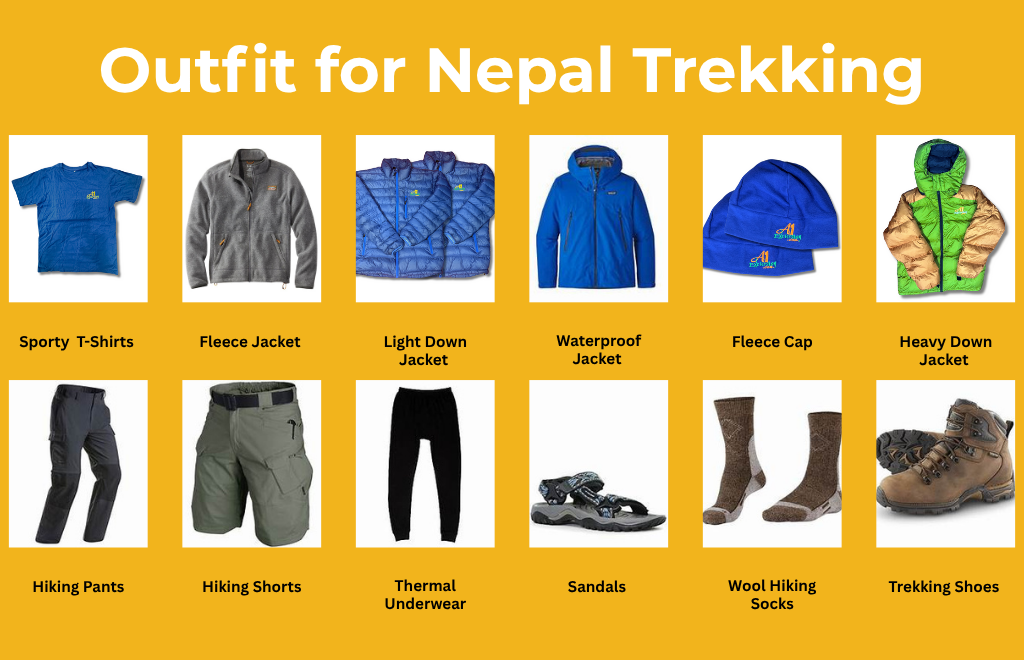Recommended Nepal Trekking pack list by A1 Excursion Adventure
This Nepal trekking pack list comprises gear that we find most essential for a trek. We believe this gear provides the best value for your next adventure in Nepal.
Clothing Essentials for Nepal Trekking: Layering System
Choosing the right hiking clothes for trekking in Nepal is crucial for comfort and safety. Opt for moisture-wicking layers and avoid cotton for improved insulation and faster drying. These are must-haves for any Nepal trekking essentials list.

Upper Body Layers
Base Layer (Moisture-Wicking)
- Sporty T-Shirts (Short & Long Sleeve): Quick-drying and sweat-wicking. Avoid cotton.(2-3)
- Lightweight Thermal Tops: For warmth and moisture management.
Mid Layer (Insulation)
- Fleece Jacket or Jumper: Ideal as an insulating mid-layer.
- Down Jacket (Returnable): Essential for colder, high-altitude conditions.
Outer Layers (Protection)
- Waterproof Jacket (Gore-Tex recommended): Protects against wind, rain, and snow.
- Fleece Cap & Sun Hat: A fleece cap for cold evenings and a sun hat for daytime protection.
- Neck Gaiter or Scarf: Useful against dust, wind, and cold air.
Lower Body Layers:
- Thermal Long Underwear Sets: Keep you warm at high altitudes.
- Gore-Tex Pants / Waterproof Shell Pants: Critical for wet or snowy conditions.
- Lightweight Hiking Pants or Convertible Pants: Breathable and fast-drying.
- Hiking Shorts / Long Shorts: Great for warmer days at lower elevations.
- Fleece or Tracksuit Pants: For relaxing around tea houses or sleeping.
- Thermal Underwear: Extra warmth for cold nights.
Footwear:
- Hiking Boots (waterproof recommended): Comfortable, ankle-supporting, and reliable for rough terrain.
- Trekking Shoes with Spare Laces: Secondary pair for flexibility.
- Sandals for Camp: Let your feet breathe post-hike.
- Inner Thin Socks + Wool Hiking Socks: Use layers for warmth and blister prevention.
Handwear:
- Lightweight Gloves: Use as inner liners in milder weather.
- Heavyweight Waterproof Gloves: For snow, rain, or colder treks.
Headwear:
- Woolen Hat / Beanie: Keeps your head and ears warm in cold, high-altitude areas.
- Sun Hat / Wide-Brimmed Hat: Protects your face and neck from strong mountain sun.
- Neck Gaiter / Buff / Scarf: Shields your neck and face from cold wind, dust, and sun.
- Bandana: A Versatile item for dust protection, wiping sweat, or covering your head.
Core Trekking Gear for Nepal

Your core trekking gear for Nepal should include a sturdy duffel or rucksack bag, a sleeping bag, and trekking poles. This trekking equipment keeps you prepared for the demands of the Himalayan terrain and temperature shifts.
- Backpack (30 - 50L) + Daypack (if using a porter)
- Duffel Bag (if using a porter, 60 - 90L, waterproof)
- Down Sleeping Bag + Inner Liner: -10°C to -15°C for high-altitude treks
- Trekking Poles: Lightweight, collapsible poles reduce knee stress and aid balance on steep trails.
Health & First Aid for Nepal Trekking

This Nepal hiking checklist is incomplete without a personal first-aid kit. Do not forget to pack essentials like Diamox, bandages, and pain relievers for peace of mind and in case of emergency, as altitude, cold, and tough trails may cause issues during your trek.
Personal First Aid Kit: Include basics like
- Brufen
- Antibiotics
- Diamox (for altitude sickness)
- Paracetamol
- Plasters, bandages
- Iodine, tinctures
- Crack bandage
Pro tip: Familiarize yourself with how to use every item in your kit, or consult your doctor or guide beforehand.
Toiletries & Personal Care for Trekking Hygiene

Hygiene is important, even in remote trails of Nepal. Bring biodegradable soap, a quick-dry towel, toilet paper, and hand sanitizer, which are essential to staying clean and fresh throughout the trek. These items ensure comfort and cleanliness, as such amenities may not be available throughout the trek.
- Toothbrush & toothpaste
- Soap (biodegradable preferred)
- Quick-drying towel
- Sunscreen, moisturizer
- Toilet paper and wet wipes
- Hand sanitizer
- Small mirror & nail cutter
Electronics & Navigation for Nepal Trekking
From headlamps to GPS, this travel gear for Nepal helps with navigation, safety, and capturing memories. Don’t forget extra batteries for remote trails where power sources may be limited.
- Headlamp or Flashlight + Extra Batteries: Headlamps are best for hands-free use at night.
- Mobile Phone & Power Bank: Essential for communication and navigation apps.
- Camera (with Extra Memory Cards): Capture your trek in stunning detail.
- Compass/Map/GPS: Useful if trekking independently or off-grid.
- Two-way radios: Helpful for group communication in remote regions.
- Binoculars: Spotting distant peaks or wildlife.
Extras & Personal Touches for Your Himalayan Trek

Trail maps, earplugs, and notebooks aren’t mandatory, but they do enhance your experience while trekking. You can also customize your Everest Base Camp gear list or Annapurna Base Camp packing needs with these personal touches for extra comfort.
- UV-protected sunglasses: A must to prevent snow blindness at altitude.
- Sunscreen (SPF 50+): Apply frequently to exposed skin.
- Water Bottle/Hydration Bladder (2-3L) + Water Purification Tablets/Steripen
- Insulated Flask or Cup: Keep liquids warm or cool depending on the season.
- Reusable Utensils (Plate, Spoon, Cup): Helps reduce plastic waste.
- High-Energy Snacks/Protein Bars: Great for quick energy on the trail.
- Personal Snacks (dry fruits, chocolates, etc.): Lightweight and satisfying.
- Trail guides and maps
- Earplugs for shared accommodation
- Safety pins or small repair kits
Documents For Nepal Trekking
Visa and Passport: Obtain the required visa for Nepal and ensure your passport is valid for at least six months after the date of entry.
Insurance for Travel: Purchase all-inclusive travel insurance that includes coverage for high-altitude trekking.
Tickets and Permits: Get all the permits required for the particular hiking route you intend to follow.
The Mustang Region Trek is the best choice if you want to go trekking to experience the raw beauty of Nepal.
Season-Specific Nepal Trekking Packing Tips
The weather in Nepal's mountains can vary a lot depending on the season. To help you stay comfortable and safe, here’s a breakdown of what to pack for Nepal trekking based on different trekking seasons:
Spring (March – May)
Weather: Mild to warm days, cooler nights, blooming flowers
Packing Tips:
- Light base layers for daytime
- Fleece or insulated jacket for chilly mornings and evenings
- Breathable hiking pants
- A light rain jacket (for occasional showers)
- Sunglasses and sunscreen for sunny trails
- Allergy meds (spring blooms can trigger sneezing for some)
Summer / Monsoon (June – August)
Weather: Warm, humid, heavy rainfall at lower elevations
Packing Tips:
- Waterproof rain jacket and rain pants
- Quick-dry t-shirts and pants
- Waterproof backpack cover and dry bags
- Leech socks if trekking in lower regions
- Light fleece for cooler areas
- Extra clothes (to change out of wet items)
- Bug spray or repellent
Tip: Trekking in Upper Mustang or Dolpo is preferable during this time, as they lie in the rain shadow and receive very little rainfall.
Autumn (September – November)
Weather: Clear skies, great visibility, cool mornings/evenings
Packing Tips:
- Ideal time for Nepal trekking — pack light layers
- Thermal layers for higher altitudes
- Windproof jacket for high passes
- Beanie and gloves for nighttime
- Extra memory cards — views are stunning this time of year!
Winter (December – February)
Weather: Cold and snowy in high altitudes, dry and sunny in lowlands
Packing Tips:
- Heavy down jacket (especially above 3,000m)
- Warm thermal underwear
- Insulated gloves, a woolen hat, and thick socks
- Four-season sleeping bag
- Lip balm and moisturizers to avoid dry skin
- Hot water bottle or heat packs (optional but helpful)
Important Note: Some high passes (like Thorong-La 5,416m) may be closed due to snow, so always check the latest trail conditions before planning.
Conclusion
Nepal trekking is truly one of the most unforgettable adventures you can have, with breathtaking trails likeEverest Base CampandAnnapurna Base Camp. With the right preparation and the packing checklist like the one above, you'll be ready for the journey.
Always be mindful of nature, respect the local culture, and support fellow travelers along the way.
And if you’re unsure about what to pack or need help planning your trek in Nepal, don’t hesitate to reach out to us on WhatsApp. We’re happy to answer your questions, help you customize your trip, and suggest the best options for your trek.
Need quick help? CONTACT US anytime!
Frequently Asked Questions
1. Can first-time trekkers go trekking in Nepal?
Absolutely! Nepal has many beginner-friendly trails like the Langtang Valley Trek and Ghorepani Poon Hill that are perfect for those new to trekking.
2. Can I rent gear for Nepal trekking?
Absolutely! Kathmandu has quality rental shops for down jackets ($2-3/day), sleeping bags ($1.5-2.5/day), and trekking poles.
3. Is a trekking guide necessary in Nepal?
While solo trekking is possible on some routes, hiring a licensed guide ensures better safety, route knowledge, and cultural insight, especially in less-traveled areas.
4. How much physical preparation is needed for a Nepal trek?
Trek difficulty varies, but it’s a good idea to build up your endurance with regular walking, cardio, and light strength training before your trip.
5. What should I know about altitude sickness in Nepal?
Altitude sickness can occur above 2,500 meters. Go slow, stay hydrated, and allow time for acclimatization to reduce the risk.
6. Do I need special permits to trek in Nepal?
Yes, most treks require permits like the TIMS card and national park entry passes. The requirements depend on your chosen trekking region.
7. What’s the best gear to pack for trekking in Nepal?
Layered clothing, waterproof gear, trekking poles, and a good pair of hiking boots are essential. Refer to our detailed Nepal trekking gear checklist for a full list.
8. Are there age limits for trekking in Nepal?
There’s no official age limit, but trekkers should be in good health. Children and seniors can enjoy moderate treks with proper planning and support.
9. Is travel insurance required for Nepal trekking?
Yes, travel insurance with high-altitude trekking coverage is strongly advised in case of emergencies like evacuation or illness.
10. Can I charge my devices during the trek in Nepal?
In popular trekking routes, teahouses often have charging facilities for a small fee. Carrying a power bank is still recommended for backup.








-1.webp)
-1.webp)
.webp)